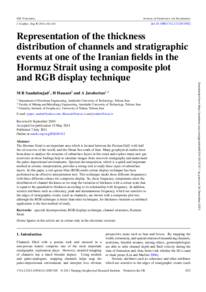Document
Representation of the thickness distribution of channels and stratigraphic events at one of the Iranian fields in the Hormuz Strait using a composite plot and RGB display technique.
Identifier
DOI: 10.1088/1742-2132/8/3/002
Contributors
Hassani, H., Author
Javaherian, A., Author
Publisher
IOP Publishing.
Gregorian
2011-07
Language
English
Subject
English abstract
The Hormuz Strait is an important area which is located between the Persian Gulf, with half the oil reserves of the world, and the Oman Sea south of Iran. Many geophysical studies have been done to analyse the structure of subsurface layers in this strait and explore many new gas reservoirs as these findings help to simulate images from reservoir stratigraphy and understand the paleo-depositional environments. Spectral decomposition, which is a quick and important method in seismic interpretation, provides a strong tool to study these types of subsurface layers. In this paper, a red-green-blue (RGB) multi-colour display technique has been performed as an effective interpretation tool. This technique stacks three different frequencies with three different colours for composite display. So, these frequency components show the distribution of channel thickness as we map the variation of thickness with a colour scale that is equal to the quantitative thickness according to its relationship with frequency. In addition, seismic attributes such as coherency, peak and instantaneous frequency, which are sensitive to the edges of stratigraphic events (such as channels), are shown with a composite plot too; although the RGB technique is better than other techniques, for thickness variation a combined application is the best method of study.
Member of
ISSN
1742-2132
Resource URL
Category
Journal articles

